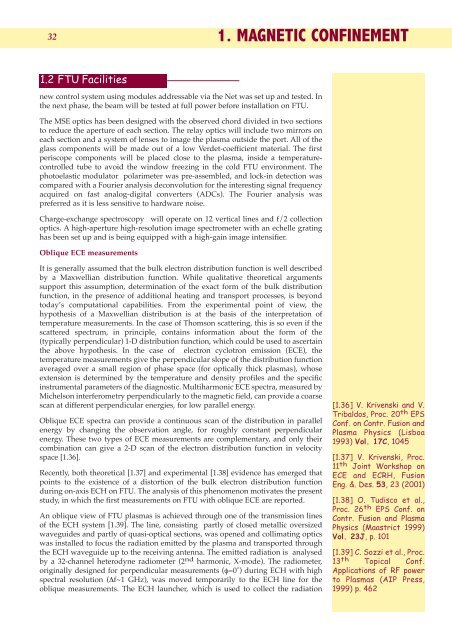1. magnetic confinement - ENEA - Fusione
1. magnetic confinement - ENEA - Fusione
1. magnetic confinement - ENEA - Fusione
You also want an ePaper? Increase the reach of your titles
YUMPU automatically turns print PDFs into web optimized ePapers that Google loves.
32<br />
<strong>1.</strong> MAGNETIC CONFINEMENT<br />
<strong>1.</strong>2 FTU Facilities<br />
new control system using modules addressable via the Net was set up and tested. In<br />
the next phase, the beam will be tested at full power before installation on FTU.<br />
The MSE optics has been designed with the observed chord divided in two sections<br />
to reduce the aperture of each section. The relay optics will include two mirrors on<br />
each section and a system of lenses to image the plasma outside the port. All of the<br />
glass components will be made out of a low Verdet-coefficient material. The first<br />
periscope components will be placed close to the plasma, inside a temperaturecontrolled<br />
tube to avoid the window freezing in the cold FTU environment. The<br />
photoelastic modulator polarimeter was pre-assembled, and lock-in detection was<br />
compared with a Fourier analysis deconvolution for the interesting signal frequency<br />
acquired on fast analog-digital converters (ADCs). The Fourier analysis was<br />
preferred as it is less sensitive to hardware noise.<br />
Charge-exchange spectroscopy will operate on 12 vertical lines and f/2 collection<br />
optics. A high-aperture high-resolution image spectrometer with an echelle grating<br />
has been set up and is being equipped with a high-gain image intensifier.<br />
Oblique ECE measurements<br />
It is generally assumed that the bulk electron distribution function is well described<br />
by a Maxwellian distribution function. While qualitative theoretical arguments<br />
support this assumption, determination of the exact form of the bulk distribution<br />
function, in the presence of additional heating and transport processes, is beyond<br />
today’s computational capabilities. From the experimental point of view, the<br />
hypothesis of a Maxwellian distribution is at the basis of the interpretation of<br />
temperature measurements. In the case of Thomson scattering, this is so even if the<br />
scattered spectrum, in principle, contains information about the form of the<br />
(typically perpendicular) 1-D distribution function, which could be used to ascertain<br />
the above hypothesis. In the case of electron cyclotron emission (ECE), the<br />
temperature measurements give the perpendicular slope of the distribution function<br />
averaged over a small region of phase space (for optically thick plasmas), whose<br />
extension is determined by the temperature and density profiles and the specific<br />
instrumental parameters of the diagnostic. Multiharmonic ECE spectra, measured by<br />
Michelson interferometry perpendicularly to the <strong>magnetic</strong> field, can provide a coarse<br />
scan at different perpendicular energies, for low parallel energy.<br />
Oblique ECE spectra can provide a continuous scan of the distribution in parallel<br />
energy by changing the observation angle, for roughly constant perpendicular<br />
energy. These two types of ECE measurements are complementary, and only their<br />
combination can give a 2-D scan of the electron distribution function in velocity<br />
space [<strong>1.</strong>36].<br />
Recently, both theoretical [<strong>1.</strong>37] and experimental [<strong>1.</strong>38] evidence has emerged that<br />
points to the existence of a distortion of the bulk electron distribution function<br />
during on-axis ECH on FTU. The analysis of this phenomenon motivates the present<br />
study, in which the first measurements on FTU with oblique ECE are reported.<br />
An oblique view of FTU plasmas is achieved through one of the transmission lines<br />
of the ECH system [<strong>1.</strong>39]. The line, consisting partly of closed metallic oversized<br />
waveguides and partly of quasi-optical sections, was opened and collimating optics<br />
was installed to focus the radiation emitted by the plasma and transported through<br />
the ECH waveguide up to the receiving antenna. The emitted radiation is analysed<br />
by a 32-channel heterodyne radiometer (2 nd harmonic, X-mode). The radiometer,<br />
originally designed for perpendicular measurements (φ=0˚) during ECH with high<br />
spectral resolution (∆f~1 GHz), was moved temporarily to the ECH line for the<br />
oblique measurements. The ECH launcher, which is used to collect the radiation<br />
[<strong>1.</strong>36] V. Krivenski and V.<br />
Tribaldos, Proc. 20 th EPS<br />
Conf. on Contr. Fusion and<br />
Plasma Physics (Lisboa<br />
1993) Vol. 17C, 1045<br />
[<strong>1.</strong>37] V. Krivenski, Proc.<br />
11 th Joint Workshop on<br />
ECE and ECRH, Fusion<br />
Eng. &. Des. 53, 23 (2001)<br />
[<strong>1.</strong>38] O. Tudisco et al.,<br />
Proc. 26 th EPS Conf. on<br />
Contr. Fusion and Plasma<br />
Physics (Maastrict 1999)<br />
Vol. 23J, p. 101<br />
[<strong>1.</strong>39] C. Sozzi et al., Proc.<br />
13 th Topical Conf.<br />
Applications of RF power<br />
to Plasmas (AIP Press,<br />
1999) p. 462













